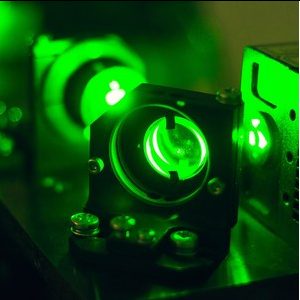Scientists of Samara National Research University are developing and space testing an ultralight optical Earth remote sensing (ERS) system. This invention will facilitate and cheapen the construction of large satellite constellation for continuous monitoring of the Earth surface. The miniature devices weighting only a few grams will be also implemented for unmanned aerial vehicles as cameras.
.jpg) Diffractive optical elements (DOE)
Diffractive optical elements (DOE)
The work is carried out due to the grant of the Innovation Promotion Fund supported by the Samara region government and the Ministry of Economic Development and Investments and awarded to the scientists. The future optical system is based on a planar diffractive lens (created at Samara University earlier) replacing a lens and mirrors system (catadioptric optical system) of modern telephoto lens. [
1]. Manufacturing such lenses, the fused quartz glass surface is coated with a photoresist - a light-sensitive material with a thickness of 10 micrometers (for comparison, the thickness of a human hair is 40-90 micrometers). A 256-level microrelief is engraved on the photoresist with a laser beam. The photoresist enables zooming in on an object , and the computer image processing based on deep neural networks provides the distortion compensation. [
2]
"These optics are light and cheap. We can make an analogue of a 300 mm lens weighing about 10 grams and costing about 500 rubles. Our task is to validate the technology and put the nanosatellite with our optics in orbit", Artem Nikinorov, a professor of the Department of Supercomputers and General Informatics of Samara University, reported.
The Samara invention is planned to be installation-ready on a nanosatellite in late 2020 - early 2021. As noted by the scientists, the resolution capability of miniature nanosatellite optical systems will be worse than one of specialized optics of mounted on larger ERS spacecrafts. First samples of such optical systems are expected to have a resolution of several dozens of meters from the altitude of the orbit of 400 km. However, low-cost nanosatellites with small optics will provide a basis for development of large orbital constellations hundreds of similar spacecrafts. That will allow almost real time monitoring of the Earth due to the instantaneous image acquisition and the absence of necessity to wait for one or another large remote sensing satellite to be above a particular part of the Earth’s surface. The acquired data will be important for the fast track of, for example, the spread of natural fires, floods, agricultural crops and other purposes.
For reference
Samara University is one of the world leaders in the field of diffraction optical elements and image processing research. The diffraction lens developed at the University is one of 40-year work results of the Diffraction Optics and Nanophotonics School supervised by an Academician of the Russian Academy of Sciences (RAS), the President of the Samara University, Victor Soifer.
The first article of Samara University scientists confirming the possibility of using diffraction optics in imaging systems was published in May 2015 following the results of the largest world conference on image processing - IEEE Computer Vision and Pattern Recognition [3]. In November 2015, the joint work of the University of Toronto and the King Abdullah University, Saudi Arabia, dedicated to a similar development was published with reference to the Samara University research. Previously, no one in the world used diffraction optics to produce high-resolution colour image.
.jpg)

.jpg)